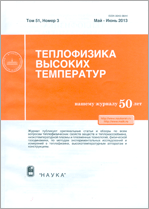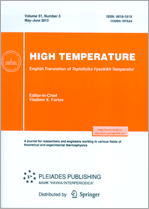|
|
Teplofizika vysokikh temperatur, 2010, Volume 48, Issue 3, Pages 383–395
(Mi tvt743)
|
 |
|
 |
This article is cited in 35 scientific papers (total in 35 papers)
Thermophysical Properties of Materials
Molecular-dynamic simulation of the thermophysical properties of liquid uranium
D. K. Belashchenkoa, D. E. Smirnovaa, O. I. Ostrovskii
a National University of Science and Technology «MISIS»
Abstract:
The procedure for the calculation of the embedded atom model (EAM) potential, which involves the use of data on the structure of liquid metal in the vicinity of the melting temperature and of the results of impact tests, is applied to uranium. The use of the method of molecular dynamics and of the EAM potential produces good agreement with experiment as regards the structure, density, and potential energy of liquid metal at temperatures up to $5000$ K, as well as along the shock adiabat up to pressures of $\sim 360$ GPa. The thermodynamic properties of solid (bcc) and liquid uranium are determined at pressures up to $470$ GPa and temperatures up to $12\,000$ K. The predicted value of bulk modulus of liquid at $1406$ K is close to the actual value. The self-diffusion coefficient under isobaric heating increases with temperature by the power law with exponent of $\sim 2\times 10^3$. The Stokes–Einstein relation is used to determine the dynamic viscosity at temperatures up to $6000$ K. The obtained potential is not quite adequate for describing crystalline uranium under normal conditions. The melting temperature of uranium with EAM potential is equal to $1455 \pm 2$ K and somewhat higher than real. The melting temperature monotonically increases with pressure and reaches the value of $7342$ K at $444$ GPa. For obtaining agreement with experimental data for energy of uranium along the $p = 0$ isobar, it is assumed that an additional contribution to energy emerges at elevated temperatures, which is due to excitation of atomic electrons and leads to a high heat capacity: it may be as high as almost $100$ kJ/mol at $5000$ K. This contribution further causes a high heat capacity of highly compressed states of uranium.
Received: 15.12.2008
Citation:
D. K. Belashchenko, D. E. Smirnova, O. I. Ostrovskii, “Molecular-dynamic simulation of the thermophysical properties of liquid uranium”, TVT, 48:3 (2010), 383–395; High Temperature, 48:3 (2010), 363–375
Linking options:
https://www.mathnet.ru/eng/tvt743 https://www.mathnet.ru/eng/tvt/v48/i3/p383
|


|





 Contact us:
Contact us: Terms of Use
Terms of Use
 Registration to the website
Registration to the website Logotypes
Logotypes








 Citation in format
Citation in format 
